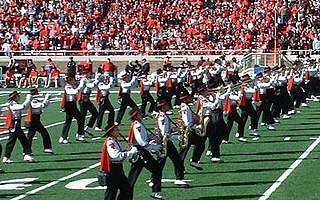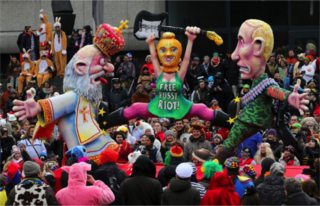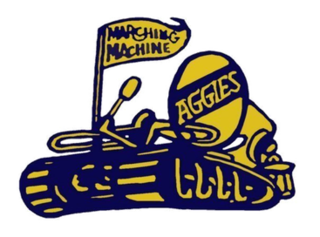
A marching band is a group of instrumental musicians who perform while marching, often for entertainment or competition. They are most popular in the United States, though not uncommon in other parts of the world. Instrumentation typically includes brass, woodwind, and percussion instruments. Most marching bands wear a uniform, often of a military style, that includes an associated organization's colors, name or symbol. Most high school marching bands, and some college marching bands, are accompanied by a color guard, a group of performers who add a visual interpretation to the music through the use of props, most often flags, rifles, and sabers.
The Dallas Cowboys Cheerleaders are the National Football League cheerleading squad representing the Dallas Cowboys team.

Color guards or Flag corps are teams of performers who perform choreographed dances and routines with various equipment to enhance and interpret the music of a marching band or drum and bugle corps show. Color guard teams can be found in American colleges, universities, high schools, middle schools, and independent drum corps. They use various equipment including flags, fake rifles, and sabres, along with other props. Most Color Guard groups are of mixed gender but some may also be single gender.

Baton twirling is a sport that combines dance and color guard to create coordinated routines. It requires a "baton" which is metal rod, typically just slightly larger than one's dominant arm. The sport can be seen in national and international competitions including the USA Junior Olympics.

The Purdue "All-American" Marching Band is the marching band of Purdue University and performs at Purdue Boilermakers football games. The AAMB is also the official band of the Indianapolis 500 race, having held the position since 1919.

Bob Jamerson, known as Baton Bob, is a well known local character and costumed street performer, currently based in Atlanta, Georgia. Baton Bob used to live in St. Louis, Missouri and in both cities is a significant local personality. He typically marches down urban sidewalks dressed in a tutu and occasionally a tiara. As his name suggests, he almost always twirls a baton as well. His stated goal is to amuse and cheer passersby, to "lift people’s spirits and put a simple smile on people’s faces during their daily routine". He occasionally calls himself the "Ambassador of Mirth".

Twirling is a form of object manipulation where an object is twirled by one or two hands, the fingers or by other parts of the body. Twirling practice manipulates the object in circular or near circular patterns. It can also be done indirectly by the use of another object or objects as in the case of devil stick manipulation where handsticks are used. Twirling is performed as a hobby, sport, exercise or performance.

The Hawkeye Marching Band is the marching band for the University of Iowa. The band performs at all home Hawkeye football games at Kinnick Stadium in addition to other events. It is the largest and most visible musical ensemble at the university. The band was founded in 1881 as a military band, giving membership to both music students and members of the military. In 1990, the band was awarded the Louis Sudler Intercollegiate Marching Band Trophy, generally considered to be the most prestigious honor a collegiate marching band can receive.
Pep flags, also known as flaggies, short flags, small flags, or twirl flags, is the performing art of twirling one or two flag(s) as part of a choreographed routine. In the early 21st century, some school flag squads have implemented a third or even fourth flag in routines. This performing art is mainly prominent in Southern California high schools. It is mainly in high schools but a few are in elementary, middle school, and college/university levels.
National Football League Cheerleading or simply NFL Cheerleading, is a group of professional cheerleading organizations in the United States. 24 of the 32 NFL teams include a cheerleading squad in their franchise. In 1954, the Baltimore Colts became the first NFL team to have cheerleaders. They were part of Baltimore's Marching Colts.
The University of Pittsburgh Varsity Marching Band, or Pitt Band, is the college marching band at the University of Pittsburgh. The band numbers over 300 students consisting of instrumentalists, a majorette squad known as the Golden Girls, a color guard, and the drumline. The band was founded in 1911 and has won numerous awards over the years. All members of the band must pass an audition in order to join. The band is currently housed in Trees Hall; however, in 2020, the Pitt Athletic Department announced its "Victory Heights" initiative, part of the campus master plan which includes a new marching band facility slated to open in spring 2027.

Marching Mizzou, M2, or The Big 'M' of the Midwest is the performing marching band for the University of Missouri, founded in 1885 as a college military band. Originally consisting of only 12 members, it is now the largest student organization on the MU campus, drawing students from nearly every major. Marching Mizzou performs at all home football games of the Missouri Tigers football team, in addition to other university events; and expanded Mini Mizzou travels to two away games per season, while the entire band regularly follows the team to conference championship games and bowl games. Marching Mizzou's signature drill "Flip Tigers" has been a well-known tradition of its pre-game show since 1960. It is instructed by University of Missouri School of Music faculty.

The Saintsations are a cheerleading and dance squad that performs at New Orleans Saints football games. In addition, they are ambassadors for the organization and can be seen participating in various community events & projects.

Several Green Bay Packers cheerleading squads have performed in Green Bay Packers' history. The Packers became one of the first professional football teams to have a cheerleading squad, having first used cheerleaders in 1931. The squad performed for 57 years under three separate names. In 1988, it was decided that the team would cease having a professional squad cheer for them. Since 1988, the team uses collegiate squads in a limited role to cheer during home games.

The Carolina Band, or the Mighty Sound of the Southeast, is the official marching band of the University of South Carolina. This 400-member marching band performs at all South Carolina Gamecocks football home games played at Williams-Brice Stadium, as well as neutral site games, bowl games, all games against Clemson, where both the Carolina Band and Clemson's Tiger Band both perform at half time regardless of which school is hosting on a given year.

Carnival in the Netherlands is a festival held mainly in the Southern and Eastern regions of the Netherlands with an emphasis on role-reversal and the suspension of social norms, as part of celebrations of Carnival. The feast was assimilated by the Catholic Church, taking elements from ancient pagan spring festivals and is celebrated in the three days preceding the Christian holidays of Ash Wednesday and Lent.

The Blue and Gold Marching Machine is the official marching band of North Carolina A&T State University. The Blue and Gold Marching Machine performs pre-game and halftime shows at all North Carolina A&T Aggies football home games and travels to most away games.

Seishun Kozo ga Naiteiru / Yūgure wa Ameagari / Ima Koko Kara was the 58th single of the J-pop group Morning Musume. It is to be the first single released under the Morning Musume '15 name, scheduled for release on April 15, 2015.

The Marching Scarlet Knights is the marching band of Rutgers University. The band was founded in 1915 as a small military band, and since then has grown into a 330-member athletic band for the university. The Marching Scarlet Knights performs at all home Rutgers Scarlet Knights football games. The band also travels to select regular season and post season football games.



















